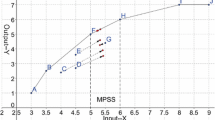Abstract
While conventional DEA models set targets separately for each DMU, in this paper we consider that there is a centralized decision maker (DM) who “owns” or supervises all the operating units. In such intraorganizational scenario the DM has an interest in maximizing the efficiency of individual units at the same time that total input consumption is minimized or total output production is maximized. Two new DEA models are presented for such resource allocation. One type of model seeks radial reductions of the total consumption of every input while the other type seeks separate reductions for each input according to a preference structure. In both cases, total output production is guaranteed not to decrease. The two key features of the proposed models are their simplicity and the fact that both of them project all DMUs onto the efficient frontier. The dual formulation shows that optimizing total input consumption and output production is equivalent to finding weights that maximize the relative efficiency of a virtual DMU with average inputs and outputs. A graphical interpretation as well as numerical results of the proposed models are presented.
Similar content being viewed by others
References
Athanassopoulos, A. D. (1995). “Goal Programming & Data Envelopment Analysis (GoDEA) for Target-Based Multi-Level Planning: Allocating Central Grants to the Greek Local Authorities.” European Journal of Operational Research 87, 535–550.
Athanassopoulos, A. D. (1998). “Decision Support for Target-Based Resource Allocation of Public Services in Multiunit and Multilevel Systems.” Management Science 44(2), 173–187.
Banker, R. D. and R. C. Morey. (1986). “Efficiency Analysis for Exogenously Fixed Inputs and Outputs.” Operations Research 34(4), 513–521.
Beasley, J. E. (2003). “Allocating Fixed Costs and Resources Via Data Envelopment Analysis.” European Journal of Operational Research 147, 198–216.
Färe, R., R. Grabowski, S. Grosskopf and S. Kraft. (1997). “Efficiency of a Fixed But Allocatable Input: A Non-Parametric Approach.” Economic Letters 56, 187–193.
Golany, B., F. Y. Phillips and J. J. Rousseau. (1993). “Models for Improved Effectiveness Based on DEA Efficiency Results.” IIE Transactions 25(6), 2–10.
Golany, B. and E. Tamir. (1995). “Evaluating Efficiency-Effectiveness-Equality Trade-offs: A Data Envelopment Analysis Approach.” Management Science 41(7), 1172–1184.
Halme, M., T. Joro, P. Korhonen, S. Salo and J. Wallenius. (1999). “A Value Efficiency Approach to Incorporating Preference Information in Data Envelopment Analysis.” Management Science 45(1), 103–115.
Kumar, C. K. and B. K. Sinha. (1999). “Efficiency Based Production Planning and Control Methods.” European Journal of Operational Research 117, 450–469.
Roll, Y., W. D. Cook and B. Golany. (1991). “Controlling Factor Weights in Data Envelopment Analysis.” IIE Transactions 23(1), 2–9.
Roll, Y. and B. Golany. (1993) “Alternate Methods of Treating Factor Weights in DEA.” Omega 21(1), 99–109.
Ruggiero, J. (1998). “Non-Discretionary Inputs in Data Envelopment Analysis.” European Journal of Operational Research 111, 461–469.
Thanassoulis, E. and R. G. Dyson. (1992). “Estimating Preferred Target Input-Output Levels Using Data Envelopment Analysis.” European Journal of Operational Research 56, 80–97.
Author information
Authors and Affiliations
Rights and permissions
About this article
Cite this article
Lozano, S., Villa, G. Centralized Resource Allocation Using Data Envelopment Analysis. Journal of Productivity Analysis 22, 143–161 (2004). https://doi.org/10.1023/B:PROD.0000034748.22820.33
Issue Date:
DOI: https://doi.org/10.1023/B:PROD.0000034748.22820.33




